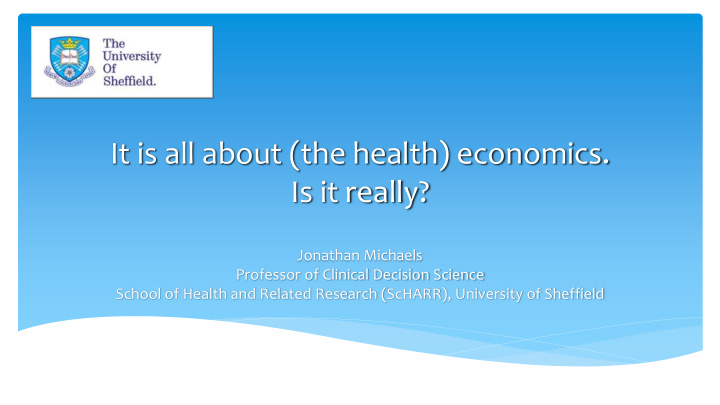



It is all about (the health) economics. Is it really? Jonathan Michaels Professor of Clinical Decision Science School of Health and Related Research (ScHARR), University of Sheffield
It is all about (the health) economics. Is it really?
It is all about (the health) economics. Is it really?
What drives NICE decisions Clinical effectiveness – always Cost effectiveness – sometimes NICE methods
NICE Processes
NICE Methods Guidance
NICE definition of ‘ICER’ Incremental cost-effectiveness ratio (ICER) The difference in the change in mean costs in the population of interest divided by the difference in the change in mean outcomes in the population of interest. NICE Glossary, 2019
NICE definition of ‘ICER’ Incremental cost-effectiveness ratio (ICER) The difference in the change in mean costs in the population of interest divided by the difference in the change in mean outcomes in the population of interest. NICE Glossary, 2019 = “value for money” (opportunity cost)
WTP Threshold
WTP Threshold
Incremental Cost Effectiveness Ratio (ICER) Treatment A Treatment B Cost – Health and social Cost A (£) Cost B (£) care perspective Outcome – Discounted Outcome A (QALY) Outcome B (QALY) quality adjusted life years 𝐷𝑝𝑡𝑢 𝐶 −𝐷𝑝𝑡𝑢 𝐵 𝐽𝐷𝐹𝑆 (𝐶 𝑠𝑓𝑚𝑏𝑢𝑗𝑤𝑓 𝑢𝑝 𝐵) = 𝑃𝑣𝑢𝑑𝑝𝑛𝑓 𝐶 −𝑃𝑣𝑢𝑑𝑝𝑛𝑓 𝐵
Incremental Cost Effectiveness Ratio (ICER) “…costs should relate to resources that are under the control of the NHS and personal and social services” Included Excluded Drugs Costs borne by patients Hospital treatment Loss of earnings and productivity Devices Benefit payments and taxation revenue Personal and social services Costs to carers/relatives Costs to other services Costs unrelated to the condition under consideration
Incremental Cost Effectiveness Ratio (ICER) “ For the cost-effectiveness analyses health effects should be expressed in QALYs. …The EQ -5D is the preferred measure of health-related quality of life in adults. ” Included Excluded HRQoL as measured by EQ-5D Other aspects of physical and mental health • Mobility Health and non-health effects on carers and • Self care relatives • Usual activities Dignity • Pain / discomfort Compassion • Anxiety /depression Processes of care Equity
Incremental Cost Effectiveness Ratio (ICER) Incremental cost effectiveness ratio What is the appropriate comparator? • Complex EVAR vs. complex open repair • Complex EVAR vs. conservative treatment • Complex EVAR vs. infra-renal open repair • Complex EVAR vs. infra-renal EVAR
Other considerations Whether there are strong reasons to indicate that the assessment of the change in • health-related quality of life has been inadequately captured, and may therefore misrepresent the health utility gained. The innovative nature of the technology, specifically if the innovation adds • demonstrable and distinctive benefits of a substantial nature which may not have been adequately captured in the reference case QALY measure. The technology meets the criteria for special consideration as a 'life-extending • treatment at the end of life' (see section 6.2.10) Aspects that relate to non-health objectives of the NHS (see sections 6.2.20 and 6.2.21). • “the Committee will take non -health objectives of the NHS into account by considering the extent to which society may be prepared to forego health gain in order to achieve other benefits that are not health related.” NICE methods guidance, 2013
Incremental Cost Effectiveness Ratio (ICER) NICE threshold: £20,000 to £30,000 per QALY Regenerative medicines; £300,000 / 10 QALY = £30,000 per QALY Screening test; £30 / 0.001 QALY = £30,000 per QALY Raising the threshold from £20,000 to £30,000 per QALY to account for some other consideration may mean a willingness to pay £10 per patient or £100,000 per patient
Conclusion It’s not all about the health economics It’s about values • What do we value about our healthcare? • How do we measure it?
Recommend
More recommend